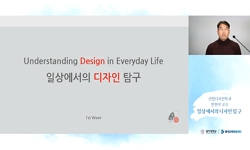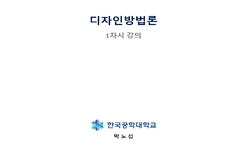Products in the current paradigm based on ICT are evolving more and more differently from those of white goods. Information-based across societies has already become usual. ICT provides knowledge information, daily information through social media, cu...
http://chineseinput.net/에서 pinyin(병음)방식으로 중국어를 변환할 수 있습니다.
변환된 중국어를 복사하여 사용하시면 됩니다.
- 中文 을 입력하시려면 zhongwen을 입력하시고 space를누르시면됩니다.
- 北京 을 입력하시려면 beijing을 입력하시고 space를 누르시면 됩니다.

LCA 개념에 의한 디자인 개발 방법론 연구 = Development of operational risk methodology designed by the LCA concept
한글로보기https://www.riss.kr/link?id=A103556924
- 저자
- 발행기관
- 학술지명
- 권호사항
-
발행연도
2017
-
작성언어
Korean
-
주제어
디자인 프로세스 ; 전과정평가 ; GUI 디자인 ; 기술 융복합 ; Design Process ; LCA ; GUI Design ; Technology Developer
-
등재정보
KCI등재
-
자료형태
학술저널
-
수록면
203-211(9쪽)
-
KCI 피인용횟수
2
- DOI식별코드
- 제공처
-
0
상세조회 -
0
다운로드
부가정보
다국어 초록 (Multilingual Abstract)
However, in reality, devices developed in various forms are mainly based on visual-transmission interface. It is developed to multimedia devices such as TV, PC, smart phones, tablet PC, video game consoles which are easily accessed around us.
Those devices are based on visual-transmission interface which is based on display.
It is current content consumption paradigm that users would consume one multimedia content through suitable ICT environment and proper display devices per certain circumstances. However, paradoxically, diversities of device means and environments to use such content tell that individual should construct each device environment and that each device should go with prior knowledge and/or experience how to use different formats.
Furthermore, there are various S/W channels in the H/W environment to use content and there are different ways to use in each SVC form.
This study considers the problem that it is necessary for ICT environment, diversities of device and diversities of SVC channel around such content to be provided as improved or developed ways on users oriented.
This is the result of the design developed based on the concepts such as user recognition on UI design methodology, use process, and UX etc.
However, users are finally forced to show different interface designs and different usability due to different interface designs and usability.
This study focuses on basically to recognize differences in the development process of interface design and to verify different interface design based on users’ evaluation method. To do this, we investigate the consciousness of the emotional problem through the representative case (through) on the preliminary study, and redefine the existing user evaluation system as the structured evaluation methodology, and conduct a concrete investigation and analysis on the display interface. The purpose of this paper is to investigate the possibility (of) as the evaluation model (for designing) to design users-oriented interface.
The results of the study are as follows.
Products in the current paradigm based on ICT are evolving more and more differently from those of white goods. Information-based across societies has already become usual. ICT provides knowledge information, daily information through social media, culture content and so on for users in various types. For users, activities to acquire all types of information from him/herself or others has turned into routine. For products, it becomes specific to deliver or provide information environment to users more conveniently and usefully. Users accept daily information and culture information including knowledge information via multi-media and it leads to diversification of devices.
However, in reality, devices developed in various forms are mainly based on visual-transmission interface. It is developed to multimedia devices such as TV, PC, smart phones, tablet PC, video game consoles which are easily accessed around us.
Those devices are based on visual-transmission interface which is based on display.
It is current content consumption paradigm that users would consume one multimedia content through suitable ICT environment and proper display devices per certain circumstances. However, paradoxically, diversities of device means and environments to use such content tell that individual should construct each device environment and that each device should go with prior knowledge and/or experience how to use different formats.
Furthermore, there are various S/W channels in the H/W environment to use content and there are different ways to use in each SVC form.
This study considers the problem that it is necessary for ICT environment, diversities of device and diversities of SVC channel around such content to be provided as improved or developed ways on users oriented.
This is the result of the design developed based on the concepts such as user recognition on UI design methodology, use process, and UX etc.
However, users are finally forced to show different interface designs and different usability due to different interface designs and usability.
This study focuses on basically to recognize differences in the development process of interface design and to verify different interface design based on users’ evaluation method. To do this, we investigate the consciousness of the emotional problem through the representative case (through) on the preliminary study, and redefine the existing user evaluation system as the structured evaluation methodology, and conduct a concrete investigation and analysis on the display interface. The purpose of this paper is to investigate the possibility (of) as the evaluation model (for designing) to design users-oriented interface.
The results of the study are as follows.
국문 초록 (Abstract)
그러나 다양한 형태로 발전되는 디바이스의 형태는 거의 대부분이 시각전달 인터페이스를 기반으로 하는것으로 발전하고 있는 것이 현실이다. 주변에서 쉽게접할 수 있는 멀티미디어 디바이스로 TV, PC, 스마트폰, 태블릿 PC, 게임기 등의 형태로 발전하고 있는데이는 디스플레이를 기반으로 한 시각전달 인터페이스를 기반으로 하고 있다.
하나의 멀티미디어 콘텐츠를 사용자는 그때그때의상황에 맞는 ICT 환경과 상황에 맞는 디스플레이 디바이스를 이용하여 소비하는 형태를 보이는 것이 현재의 콘텐츠 소비 패러다임이라고 할 수 있는 것이다.
사용자가 콘텐츠 이용에 있어 다양한 디바이스 수단을 이용할 수 있는 것은 매우 좋은 환경이다. 그러나역설적으로 이러한 콘텐츠를 이용하의 디바이스 수단과 환경이 다양하다는 것은 또한 각각의 디바이스 환경을 개인이 소화 또는 구축해야 한다는 것과 각각의 디바이스마다 상이한 형식의 이용 방법에 대한 사전인지나 경험 등이 수반되어야 한다는 것과 같다.
나아가 콘텐츠 이용의 H/W적 환경에 S/W 채널 역시 다양하며 각각의 SVC형태로 저마다 다른 이용 방법을 제공하고 있다.
본 연구는 이러한 콘텐츠를 둘러싼 ICT환경, 디바이스 다양성, SVC채널 다양성이 사용자를 중심으로보다 개선되거나 발전된 형태로 제공 될 필요가 있다는 점에 그 문제의식을 두고 있다.
이는 UI 디자인 방법론에 입각한 사용자 인지, 사용과정, UX 등의 개념을 근간으로 개발된 디자인 결과물이다. 그러나 글한 과정에서 서로 상이한 인터페이스 디자인과 이에 따라 상이한 사용성을 보이고 있기때문에 사용자는 결과적으로 각각 다른 인터페이스 디자인과 사용성을 보일 수 밖에 없게 되는 것이다.
본 연구는 이렇게 다르게 나타나는 인터페이스 디자인 개발 과정의 상이한 점을 기본적으로 인식하고 서로 다른 인터페이스 디자인을 사용자 평가 방법에 입각하여 비교 검증하는 점에 초점을 두고 있다. 이를위해 사전 연구를 통해 대표적 사례를 통한 체감적 문제의식을 알아보고 기존의 사용자 평가 시스템을 구조화된 평가방법론으로 재정립 한 후 이를 기반으로 실증 과정을 거쳐 콘텐츠를 대상으로 하는 디스플레이인터페이스에 대한 구체적 조사, 분석 과정을 거쳐 보다 사용자 중심적 인터페이스를 디자인하기 위한 평가모델로써의 가능성을 알아보는 데 그 목적이 있다.
연구의 결과는 다음과 같다.
ICT를 기반으로 한 현 방송통신 패러다임에서의 제품은 백색가전과 그 성격을 점점 달리하며 발전하고있다. 사회 전반에 걸쳐 정보를 기반으로 하는 것이이미 일상적인 것이 되었다. ICT는 다...
ICT를 기반으로 한 현 방송통신 패러다임에서의 제품은 백색가전과 그 성격을 점점 달리하며 발전하고있다. 사회 전반에 걸쳐 정보를 기반으로 하는 것이이미 일상적인 것이 되었다. ICT는 다양한 형태로사용자에게 지식정보, SNS 로 대표되는 일상 정보, 문화 콘텐츠 등을 제공한다. 사용자는 이러한 모든 형태의 정보를 스스로 또는 외부로부터 얻는 활동이 일상화되어 있다. 제품은 이러한 정보 환경을 사용자에게 보다 편리하고 유용하게 전달 또는 제공할 수 있는 형태로 구체화 되고 있다. 지식정보를 비록한 일상의 정보나 문화 정보는 멀티미디어 형태로 사용사가수용하며 이는 디바이스의 다양화로 이어지고 있다.
그러나 다양한 형태로 발전되는 디바이스의 형태는 거의 대부분이 시각전달 인터페이스를 기반으로 하는것으로 발전하고 있는 것이 현실이다. 주변에서 쉽게접할 수 있는 멀티미디어 디바이스로 TV, PC, 스마트폰, 태블릿 PC, 게임기 등의 형태로 발전하고 있는데이는 디스플레이를 기반으로 한 시각전달 인터페이스를 기반으로 하고 있다.
하나의 멀티미디어 콘텐츠를 사용자는 그때그때의상황에 맞는 ICT 환경과 상황에 맞는 디스플레이 디바이스를 이용하여 소비하는 형태를 보이는 것이 현재의 콘텐츠 소비 패러다임이라고 할 수 있는 것이다.
사용자가 콘텐츠 이용에 있어 다양한 디바이스 수단을 이용할 수 있는 것은 매우 좋은 환경이다. 그러나역설적으로 이러한 콘텐츠를 이용하의 디바이스 수단과 환경이 다양하다는 것은 또한 각각의 디바이스 환경을 개인이 소화 또는 구축해야 한다는 것과 각각의 디바이스마다 상이한 형식의 이용 방법에 대한 사전인지나 경험 등이 수반되어야 한다는 것과 같다.
나아가 콘텐츠 이용의 H/W적 환경에 S/W 채널 역시 다양하며 각각의 SVC형태로 저마다 다른 이용 방법을 제공하고 있다.
본 연구는 이러한 콘텐츠를 둘러싼 ICT환경, 디바이스 다양성, SVC채널 다양성이 사용자를 중심으로보다 개선되거나 발전된 형태로 제공 될 필요가 있다는 점에 그 문제의식을 두고 있다.
이는 UI 디자인 방법론에 입각한 사용자 인지, 사용과정, UX 등의 개념을 근간으로 개발된 디자인 결과물이다. 그러나 글한 과정에서 서로 상이한 인터페이스 디자인과 이에 따라 상이한 사용성을 보이고 있기때문에 사용자는 결과적으로 각각 다른 인터페이스 디자인과 사용성을 보일 수 밖에 없게 되는 것이다.
본 연구는 이렇게 다르게 나타나는 인터페이스 디자인 개발 과정의 상이한 점을 기본적으로 인식하고 서로 다른 인터페이스 디자인을 사용자 평가 방법에 입각하여 비교 검증하는 점에 초점을 두고 있다. 이를위해 사전 연구를 통해 대표적 사례를 통한 체감적 문제의식을 알아보고 기존의 사용자 평가 시스템을 구조화된 평가방법론으로 재정립 한 후 이를 기반으로 실증 과정을 거쳐 콘텐츠를 대상으로 하는 디스플레이인터페이스에 대한 구체적 조사, 분석 과정을 거쳐 보다 사용자 중심적 인터페이스를 디자인하기 위한 평가모델로써의 가능성을 알아보는 데 그 목적이 있다.
연구의 결과는 다음과 같다.
참고문헌 (Reference)
1 "http://www.cosfly.com/service/product.html"
2 Son, M. J., "Life Cycle Assessment of Power Generation System in Korea" Konkuk University 2012
3 Park, Sun Won., "LCA for Environmental Impacts of Alternative Technology -Detergent and Detergent-free Washing System-" 5 (5): 2004
4 Wi, Jang-Hoon., "Development of operational risk methodology designed by the LCA concept" 2016
1 "http://www.cosfly.com/service/product.html"
2 Son, M. J., "Life Cycle Assessment of Power Generation System in Korea" Konkuk University 2012
3 Park, Sun Won., "LCA for Environmental Impacts of Alternative Technology -Detergent and Detergent-free Washing System-" 5 (5): 2004
4 Wi, Jang-Hoon., "Development of operational risk methodology designed by the LCA concept" 2016
동일학술지(권/호) 다른 논문
-
혼돈된 상황의 감정을 표현한 도자조형연구 - 마블링기법을 중심으로 -
- 한국전시산업융합연구원
- 박이슬
- 2017
- KCI등재
-
4차 산업시대 공공미술의 역할과 범위의 적용사례 - 안양역 기부계단 프로젝트 <생명-나비-4차산업>을 중심으로 -
- 한국전시산업융합연구원
- 김현정
- 2017
- KCI등재
-
- 한국전시산업융합연구원
- 남종현
- 2017
- KCI등재
-
북한이탈주민 학생들의 on-line 대학교에서의 교육경험과 그들의 필요
- 한국전시산업융합연구원
- 이문숙
- 2017
- KCI등재
분석정보
인용정보 인용지수 설명보기
학술지 이력
| 연월일 | 이력구분 | 이력상세 | 등재구분 |
|---|---|---|---|
| 2022 | 평가예정 | 재인증평가 신청대상 (재인증) | |
| 2019-04-12 | 학술지명변경 | 외국어명 : Korean Society of Art & Design -> The Korean Society of Science & Art |  |
| 2019-01-10 | 학술지명변경 | 한글명 : 한국과학예술포럼 -> 한국과학예술융합학회외국어명 : Korea Science & Art Forum -> Korean Society of Art & Design |  |
| 2019-01-01 | 평가 | 등재학술지 유지 (계속평가) |  |
| 2016-01-01 | 평가 | 등재학술지 유지 (계속평가) |  |
| 2014-01-09 | 학술지명변경 | 외국어명 : 미등록 -> Korea Science & Art Forum |  |
| 2012-01-01 | 평가 | 등재학술지 선정 (등재후보2차) |  |
| 2011-01-01 | 평가 | 등재후보 1차 PASS () |  |
| 2009-01-01 | 평가 | 등재후보학술지 선정 () |  |
학술지 인용정보
| 기준연도 | WOS-KCI 통합IF(2년) | KCIF(2년) | KCIF(3년) |
|---|---|---|---|
| 2016 | 0.5 | 0.5 | 0.49 |
| KCIF(4년) | KCIF(5년) | 중심성지수(3년) | 즉시성지수 |
| 0.5 | 0.49 | 0.707 | 0.12 |




 DBpia
DBpia






